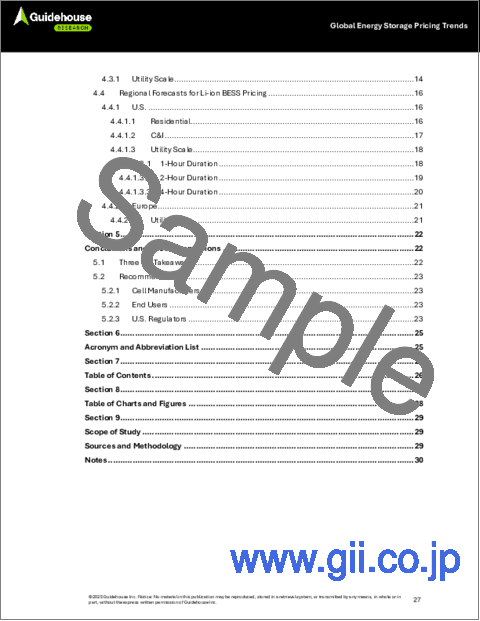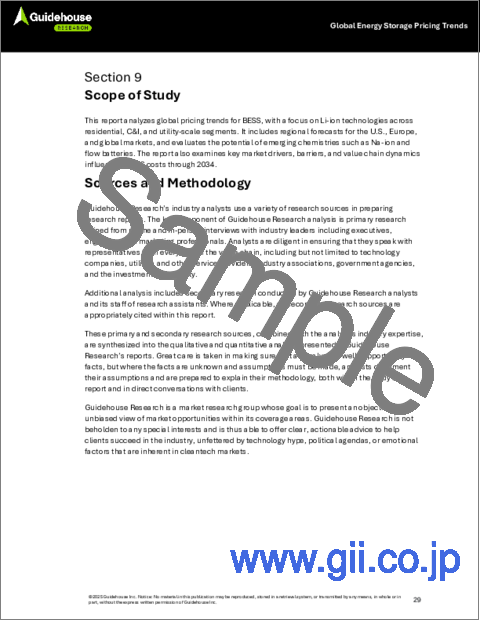|
|
市場調査レポート
商品コード
1759953
世界のエネルギー貯蔵の価格動向 - エネルギー貯蔵の市場影響因子・価格動向・将来の革新:世界市場の分析・予測 (2025-2034年)Global Energy Storage Pricing Trends - Market Forces, Pricing Trends, and Future Innovations in Energy Storage: Global Forecasts and Analysis, 2025-2034 |
||||||
|
|||||||
| 世界のエネルギー貯蔵の価格動向 - エネルギー貯蔵の市場影響因子・価格動向・将来の革新:世界市場の分析・予測 (2025-2034年) |
|
出版日: 2025年06月30日
発行: Guidehouse Research
ページ情報: 英文 32 Pages
納期: 即納可能
|
全表示
- 概要
- 図表
- 目次
EVの急成長、再生可能エネルギーの普及拡大、電力網の柔軟性向上に対するニーズの高まりから、世界のバッテリーエネルギー貯蔵システム (BESS) に対する需要は急速に高まっています。こうした動きを受けて、住宅、C&I (商業・産業)、ユーティリティの各分野で、開発事業者や電力会社はBESSの導入を拡大しています。同時に、バッテリーの化学技術の進化、自動化の進展、システム統合の高度化などがコストの継続的な低下に寄与しており、とくに主流技術であるリチウムイオンシステムでその傾向が顕著です。
しかし、今後の展望には課題も伴います。たとえば米国では、規制の不透明さや関税の影響により、価格低下のペースが鈍化しています。また世界的には、供給過剰やサプライチェーンの不安定性が、さらなるコスト改善の障害となる可能性があります。
本レポートでは、これらの力学を詳細に分析し、2034年までのリチウムイオンBESSの価格予測をシナリオベースで提示しています。予測は、地域 (米国、欧州、世界市場)、顧客タイプ、システムの運転時間別に分類されており、バッテリーパック、電力変換システム (PCS)、設置費用など、構成要素ごとのコスト内訳も詳しく示されています。
また、リチウムイオンに加え、ナトリウムイオン (Na-ion) 電池やフロー電池といった次世代技術についても理論的な分析を行い、スケール化が実現した場合のコスト競争力について評価しています。さらに、リチウムイオンのバリューチェーン構造を取り上げ、地域ごとの競合環境や、垂直統合戦略、原材料アクセスの重要性が長期的な競争力にどのように影響するかを論じています。
目次
第1章 エグゼクティブサマリー
- イントロダクション
- 市場予測
第2章 市場の問題
- 促進要因
- 技術の進歩
- 競合の激化と垂直統合
- リチウム価格の下落
- 障壁
- 米国の規制と関税
- 市場への新規製造業者の参入
- 競合の激化による過剰生産能力
- 価格
第3章 産業バリューチェーン
- リチウムイオン電池製造
- 地域の競合
- 垂直統合と競合ダイナミクス
第4章 市場予測
- 前提・調査手法
- 予測の定義
- BESS価格の世界市場の予測
- ユーティリティ規模
- リチウムイオンBESS価格の地域別予測
- 米国
- 欧州
第5章 総論・提言
- 3項目の主要ポイント
- 提言
- 電池製造業者
- エンドユーザー
- 米国の規制当局
第6章 頭字語・略語一覧
第7章 目次
第8章 図表
第9章 調査範囲、情報源、調査手法、注記
List of Tables
- Table 2-1. Utility-Scale BESS Pricing by Battery Technology, Base Case, Average Installed Cost per Kilowatt-Hour, World Markets: 2025, 2034
- Table 3-1. Li-ion Battery Storage Market Share by Capacity, Top 5 Countries: 2025
- Table 3-2. Companies Active across the Li-ion Battery Value Chain
List of Figures
- Chart 1-1. Utility-Scale Li-ion BESS Pricing, 2-Hour, Base Case, Average Installed Costs, U.S. vs. Europe: 2025-2034
- Chart 4-1. Utility-Scale Li-ion BESS Pricing by Cost Component, 20 MW/80 MWh, Base Case, Average Installed Costs, World Markets: 2025-2034
- Chart 4-2. Residential Li-ion BESS Pricing by Cost Component, 5 kW/12 kWh, Base Case, Average Installed Costs, U.S.: 2025-2034
- Chart 4-3. C&I Li-ion BESS Pricing by Cost Component, 250 kW/500 kWh, Base Case, Average Installed Costs, U.S.: 2025-2034
- Chart 4-4. Utility-Scale Li-ion BESS Pricing by Cost Component, 20 MW/20 MWh, Base Case, Average Installed Costs, U.S.: 2025-2034
- Chart 4-5. Utility-Scale Li-ion BESS Pricing by Cost Component, 20 MW/40 MWh, Base Case, Average Installed Costs, U.S.: 2025-2034
- Chart 4-6 Utility-Scale Li-ion BESS Pricing by Cost Component, 20 MW/80 MWh, Base Case, Average Installed Costs, U.S.: 2025-2034
- Chart 4-7 Utility-Scale Li-ion BESS Pricing by Cost Component, 100 MW/200 MWh, Base Case, Average Installed Costs, Europe: 2025-2034
- Figure 3-1. Li-ion Battery Value Chain
Global demand for battery energy storage systems (BESS) is accelerating, driven by the rapid growth of electric vehicles (EVs), increasing renewable energy penetration, and the need for greater grid flexibility. As a result, developers and utilities are scaling deployments across residential, commercial and industrial (C&I), and
utility-scale segments. At the same time, advances in battery chemistry, automation, and system integration are contributing to steady cost declines particularly for Li-ion systems, which remain the dominant technology.
However, the path forward is not without challenges. In the U.S., regulatory uncertainty and tariffs are slowing price reductions, while globally, overcapacity and supply chain volatility may limit further cost improvements. This report explores these dynamics in depth, providing scenario-based pricing forecasts for Li-ion BESS through 2034. Forecasts are segmented by region (U.S., Europe, and global markets), customer type, and system duration, with detailed breakdowns of cost components such as battery packs, power conversion systems, and installation.
In addition to Li-ion systems, the report includes a theoretical analysis of sodium-ion (Na-ion) and flow battery technologies, assessing their potential to compete on cost if scaled. It also examines the structure of the Li-ion value chain, highlighting regional competition, vertical integration strategies, and the role of raw material access in shaping long-term competitiveness. This report is designed to help stakeholders across the energy storage ecosystem understand pricing trends, evaluate investment opportunities, and navigate an increasingly complex market landscape.
Table of Contents
1. Executive Summary
- 1.1 Introduction
- 1.2 Market Forecast
2. Market Issues
- 2.1 Drivers
- 2.1.1 Technological Advances
- 2.1.1.1 LFP Adoption
- 2.1.1.2 Liquid Cooling Systems
- 2.1.1.3 Increased Cell and Container Size
- 2.1.1.4 Automation of BESS Production
- 2.1.1.5 Solid-State Batteries
- 2.1.2 Increased Competition and Vertical Integration
- 2.1.3 Declining Lithium Prices
- 2.1.1 Technological Advances
- 2.2 Barriers
- 2.2.1 U.S. Regulations and Tariffs
- 2.2.2 New Manufacturers in the Market
- 2.2.3 Overcapacity from Increased Competition
- 2.3 Pricing
3. Industry Value Chain
- 3.1 Li-ion Battery Production
- 3.1.1 Regional Competition
- 3.1.2 Vertical Integration and Competitive Dynamics
4. Market Forecasts
- 4.1 Assumptions and Methodology
- 4.2 Forecast Definitions
- 4.3 Global Forecasts for BESS Pricing
- 4.3.1 Utility Scale
- 4.4 Regional Forecasts for Li-ion BESS Pricing
- 4.4.1 U.S.
- 4.4.1.1 Residential
- 4.4.1.2 C&I
- 4.4.1.3 Utility Scale
- 4.4.1.3.1 1-Hour Duration
- 4.4.1.3.2 2-Hour Duration
- 4.4.1.3.3 4-Hour Duration
- 4.4.2 Europe
- 4.4.2.1 Utility Scale
- 4.4.1 U.S.
5. Conclusions and Recommendations
- 5.1 Three Big Takeaways
- 5.2 Recommendations
- 5.2.1 Cell Manufacturers
- 5.2.2 End Users
- 5.2.3 U.S. Regulators





